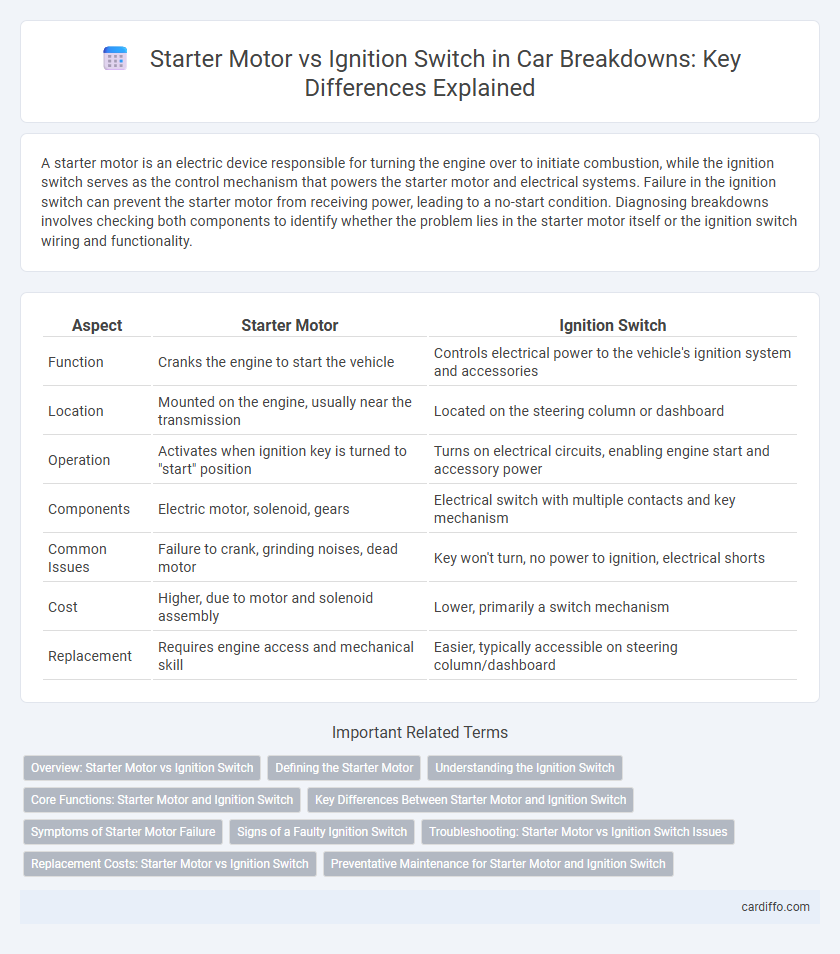A starter motor is an electric device responsible for turning the engine over to initiate combustion, while the ignition switch serves as the control mechanism that powers the starter motor and electrical systems. Failure in the ignition switch can prevent the starter motor from receiving power, leading to a no-start condition. Diagnosing breakdowns involves checking both components to identify whether the problem lies in the starter motor itself or the ignition switch wiring and functionality.
Table of Comparison
| Aspect | Starter Motor | Ignition Switch |
|---|---|---|
| Function | Cranks the engine to start the vehicle | Controls electrical power to the vehicle's ignition system and accessories |
| Location | Mounted on the engine, usually near the transmission | Located on the steering column or dashboard |
| Operation | Activates when ignition key is turned to "start" position | Turns on electrical circuits, enabling engine start and accessory power |
| Components | Electric motor, solenoid, gears | Electrical switch with multiple contacts and key mechanism |
| Common Issues | Failure to crank, grinding noises, dead motor | Key won't turn, no power to ignition, electrical shorts |
| Cost | Higher, due to motor and solenoid assembly | Lower, primarily a switch mechanism |
| Replacement | Requires engine access and mechanical skill | Easier, typically accessible on steering column/dashboard |
Overview: Starter Motor vs Ignition Switch
The starter motor is a crucial electrical device that initiates engine rotation by engaging the flywheel, while the ignition switch controls the power flow to the starter motor and other vehicle systems. The starter motor directly converts electrical energy into mechanical energy to start the engine, whereas the ignition switch acts as the interface for the driver to activate the starting sequence. Understanding the functional difference between the starter motor and ignition switch is essential for diagnosing vehicle starting issues and ensuring proper maintenance.
Defining the Starter Motor
The starter motor is a crucial component in a vehicle's engine system responsible for initiating engine combustion by turning the engine's crankshaft when the ignition switch is activated. Unlike the ignition switch, which controls the electrical flow to various systems, the starter motor directly engages with the engine to start it. Efficient functioning of the starter motor ensures reliable engine ignition and overall vehicle operation.
Understanding the Ignition Switch
The ignition switch controls the electrical power to the vehicle's starter motor, enabling engine start-up by sending current when turned. Unlike the starter motor, which physically cranks the engine, the ignition switch functions as the primary control for engaging various electrical systems, including the starter circuit. Understanding the ignition switch's role is essential for diagnosing breakdowns related to starting issues and ensuring proper vehicle operation.
Core Functions: Starter Motor and Ignition Switch
The starter motor converts electrical energy from the battery into mechanical energy to crank the engine and initiate combustion. The ignition switch controls the flow of electricity to the starter motor and other key systems, enabling the driver to start and stop the engine. Both components are essential for the engine's startup process, with the starter motor providing the physical movement while the ignition switch manages power distribution.
Key Differences Between Starter Motor and Ignition Switch
The starter motor is an electric device responsible for turning the engine over to initiate combustion, while the ignition switch controls the electrical power to the vehicle's ignition system and starter motor. A key difference lies in their function: the starter motor physically cranks the engine, whereas the ignition switch activates the starter motor and other electrical components. The starter motor experiences mechanical wear, whereas the ignition switch is mainly an electrical control component subject to contact wear and potential switch failure.
Symptoms of Starter Motor Failure
Symptoms of starter motor failure include a clicking noise when turning the key, no response or engine crank when attempting to start, and intermittent engine starting issues. The ignition switch may function correctly, but a faulty starter motor prevents the engine from turning over. Diagnosing starter motor problems involves checking for voltage at the starter terminal and inspecting for worn brushes or a failing solenoid.
Signs of a Faulty Ignition Switch
A faulty ignition switch can cause intermittent starting issues, such as the engine failing to crank or sudden stalling while driving. Other signs include dashboard lights flickering, accessories like radio or headlights cutting out unexpectedly, and a key that feels loose or difficult to turn in the ignition cylinder. Ignoring these symptoms can eventually lead to complete vehicle breakdown and expensive repairs.
Troubleshooting: Starter Motor vs Ignition Switch Issues
Troubleshooting starter motor versus ignition switch issues involves identifying symptoms such as a clicking sound or no response when turning the key, which often indicates a faulty starter motor, while issues like unresponsive dashboard lights or electrical accessories can point to ignition switch problems. Testing the starter motor includes checking voltage at the solenoid and ensuring the motor engages properly, whereas diagnosing the ignition switch requires inspecting electrical continuity and verifying power delivery to the starter circuit. Using a multimeter to assess both components helps isolate the source of the breakdown for efficient repair.
Replacement Costs: Starter Motor vs Ignition Switch
Replacement costs for a starter motor typically range from $200 to $600, influenced by vehicle model and labor complexity. Ignition switch replacement usually falls between $100 and $300, often making it a more affordable repair option. Understanding these cost differences helps prioritize repairs during vehicle breakdowns to optimize budget and functionality.
Preventative Maintenance for Starter Motor and Ignition Switch
Preventative maintenance for starter motors includes regularly checking electrical connections, cleaning terminals, and ensuring the motor receives proper voltage to avoid breakdowns. For ignition switches, routine inspection involves verifying switch operation, testing electrical continuity, and replacing worn contacts to prevent failure. Proper maintenance of both components enhances vehicle reliability and reduces the risk of unexpected engine starting issues.
Starter motor vs ignition switch Infographic

 cardiffo.com
cardiffo.com